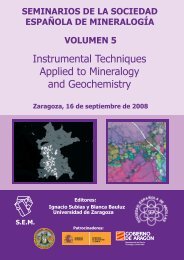XVI Reunión CientÃfica de la Sociedad Española de Arcillas - Libro ...
XVI Reunión CientÃfica de la Sociedad Española de Arcillas - Libro ...
XVI Reunión CientÃfica de la Sociedad Española de Arcillas - Libro ...
You also want an ePaper? Increase the reach of your titles
YUMPU automatically turns print PDFs into web optimized ePapers that Google loves.
Comunicaciones SEA 2001 – Baeza (Jaén)<br />
SOCIEDAD<br />
ESPAÑOLA DE ARCILLAS<br />
MÖSSBAUER SPECTROSCOPIC INVESTIGATION OF VERMICULITES<br />
FROM ANDALUSIA (SPAIN)<br />
Lerf A b , Wagner FE b , Poyato J c , Perez Rodríguez JL c , Justo A c<br />
a<br />
Meissner-Institut <strong>de</strong>r Bayer. Garching.<br />
b<br />
Physics Department. Garching.<br />
c Instituto <strong>de</strong> Ciencia <strong>de</strong> Materiales <strong>de</strong> Sevil<strong>la</strong>, CSIC.<br />
We report on a Mössbauer spectroscopic investigation (ME) of three<br />
vermiculites from Andalusia with increasing iron content (Santa O<strong>la</strong>l<strong>la</strong>,<br />
Almonaster, Ojén) and the phlogopite from Santa O<strong>la</strong>l<strong>la</strong>. A typical ME spectrum is<br />
shown in figure 1. The spectra of all samples can be interpreted with the<br />
superposition of three doublets. One of them is assigned to Fe 3+ , the other two to<br />
Fe 2+ (all in octahedral positions). According to the chemical formu<strong>la</strong> we could not<br />
i<strong>de</strong>ntify Fe 3+ in tetrahedral sites. Interestingly enough the isomer shift (IS,<br />
measured versus (Fe)Rh source) and the quadrupole splitting (QS) of the iron<br />
sites in all three samples vary only in a very small range of values <strong>de</strong>pending on<br />
the type of the sample (pow<strong>de</strong>r, single crystal) or the method of data analysis<br />
(gaussian or lorentzian profiles): IS of Fe 3+ 0.24-0.29 mm/s, IS of Fe 2+ 1.00-1,10<br />
mm/s; QS of Fe 3+ 1.02-1.10 mm/s, QS of Fe 2+ 2.51-2.61 mm/s; the only exception<br />
is the quadrupole splitting of the phlogopite from Santa O<strong>la</strong>l<strong>la</strong> which amounts to<br />
2.35 mm/s. With the exception of the phlogopite there is more Fe 3+ than Fe 2+ . The<br />
Fe 3+ /Fe 2+ ratio <strong>de</strong>termined by ME <strong>de</strong>viates more or less strongly from the ratio<br />
<strong>de</strong>termined by chemical analysis. In all spectra one observes also a broad<br />
unresolved component that is assumed to result mainly from slow paramagnetic<br />
re<strong>la</strong>xation of Fe 3+ .<br />
The values of IS and QS found for the samples investigated are in excellent<br />
agreement with the parameters found previously for di- and trioctahedral micas [1]<br />
and vermiculites [2]. It should be noted that the quadrupole splitting of the Fe 3+<br />
site is exceptionally high for trioctahedral 2:1 c<strong>la</strong>y minerals. The quadrupole<br />
splittings for the two Fe 2+ sites correspond very well with those given by Rancourt













